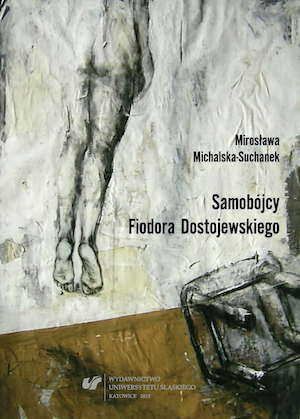Samobójcy Fiodora Dostojewskiego
Suicides in Fyodor Dostoyevsky
Author(s): Mirosława Michalska-Suchanek
Subject(s): Language and Literature Studies
Published by: Wydawnictwo Uniwersytetu Śląskiego
Keywords: Fyodor Dostoyevsky
Summary/Abstract: Fyodor Dostoyevsky was the first eminent Russian thinker who began to view a suicidalact as one of the prominent ethic problems. He projected the results of doubtfulnessin God as well as the immortality of the soul by assuming that God does not exist, andman – gaining god’s rights – is elevated as the master of the entire world. Dostoyevsky’sworks unveil further visions of reality. They are all combined by a common finale – completedevaluation, which consistently and unavoidably leads to an annihilation of theworld in the social context, and to a malefaction and suicide – in individual one.Dostoyevsky created picture of suicides who accommodate themselves in the centerof the s u ic ide -ge nerat i ng spac e, which is read as an aggregate of the dynamicallyshaped circumstances and conditions that inevitably push an individual being towardself-annihilation – this entails a gradual unveiling of this person’s inner world. Thefinal act comes to be a fatal denouement of the whirl of interrelated acts, phenomena,events, attitudes, reactions, thoughts, etc. The suicide-generating space, weavingan immanent and a transcendent world together, is formed by the life choices of thesuicides all doomed to die. The suicide is therefore not the one who ends his or her lifehere and now, but, rather, an individual who is embedded in a dynamically emergingsuicide-generating space, and is thus experiencing mutual relationships with all itscomponents.A suicide in Dostoyevsky creates an independent entity that is rooted at the pointof intersection of three layers – that is, axiological, ontological, and psychological one.This person turns to be a semantic-ideal universum framed within his or her body. Thisuniversum is a reflection of a multifaceted, deepened reflection upon the real as wellas metaphysical world. Thus depicted, the protagonist focuses on and simultaneouslycondenses the intellective as well as extra-rational knowledge about the real world. Theprotagonist functions as a prism which sees into Dostoyevsky’s philosophy, mysteriesof human nature and soul revealed by him, as well as his reflections on the social andpolitical matters.The book comprises five parts – these are: Introduction, Russia in the mid-nineteenthcentury and the issue of the suicide; Types of suicides, Suicides in Dostoyevsky, and Suicides andtheir social contexts.The part entitled Russia in the mid-nineteenth century and the issue of the suicide is anattempt at looking into Russia in Dostoyevsky times, and its description through theprism of the semantic triangle, whose cusps are formed by Dostoyevsky himself alongwith the two notions: suicide and atheism. This part deals with the essence, form andspecial character of atheism, and aside from that, its sources and ramifications. Moreover,this part depicts other reasons for the intensified suicidal acts, as well as suicide inthe context of the religious history of Russia in the opinions of Russian eminent thinkers(Solovyov, Berdyaev), and Fyodor Dostoyevsky in the main.The part Types of suicides makes an attempt at classifying the personae of suicides whoappear in the works penned by the author of The Brothers Karamazov. The classification isbased on the concepts of types of suicides defined in terms of suicidology and psychology,as well as others, unaccepted in the studies on suicide, successfully serving as toolsof literary description. The book points to and provides characteristics of five categoriesof suicides – namely, calculating egotistic, logical, fatal, escapist, and spiritual one. Tothe categorization proposed in the book the author adds a typical suicidal model thatappears in Dostoyevsky.An extensive chapter Suicides in Dostoyevsky, which gives the title to the book, constitutesits main body. It comprises twelve separate sketches devoted to the leading suicidespenned by the writer (their order of appearance matches the chronology of the workswhere they appear). The purpose of the proposed analyses is to provide detailed insightsinto a gradual intensification of the suicide-generating space, an also attribute its componentswith semantic content. Furthermore, the analyses point to broadly understoodcontexts.Suicide is treated here as a medium which enlivens the truth about moral, spiritual,and social condition of Russia in the second half of the nineteenth century. Insofar asportrayals of prominent suicides convey messages that are ethically ennobling andarchetypical, the other suicides, who insinuate the ordinary and universal nature of thisphenomenon, perform the role of a looking-glass of the society. Therein hide all the mostessential problems of the nineteenth-century Russian reality. This problem is discussedin the part entitled Suicides and their social contexts that crowns the book.
- E-ISBN-13: 978-83-8012-403-5
- Print-ISBN-13: 978-83-8012-402-8
- Page Count: 304
- Publication Year: 2015
- Language: Polish
- eBook-PDF
- Sample-PDF
- Table of Content
- Introduction

